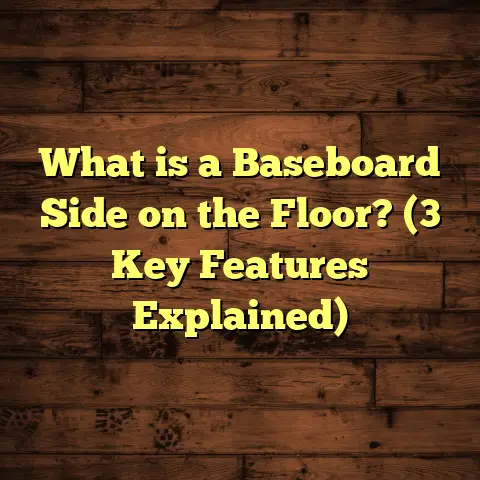What is a Floor Check? (5 Essential Steps for Success)
What is a Floor Check?
Have you ever stepped onto a floor and felt something was off? Maybe it’s a tiny creak or a spot that feels uneven under your feet. You might brush it off as nothing, but sometimes those little signs point to bigger problems beneath the surface. That’s why I always stress the importance of what I call a “floor check.” So, what exactly is a floor check?
A floor check is a systematic inspection of your floor’s condition before, during, or after installation. It involves checking everything from visible surface damage to hidden structural issues and moisture levels. Think of it like a health check-up for your flooring—spotting potential problems early so you can fix them before they become costly headaches.
I’ve spent years doing these checks in homes, offices, and big commercial spaces. Each check tells a story about the floor’s past and future. Whether it’s an old hardwood floor showing signs of water damage or new laminate that’s not laying flat, these inspections can make or break the success of any flooring project.
Why Do I Always Start With a Floor Check?
Have you ever rushed into buying new flooring material only to find out later that the floor underneath wasn’t ready? I’ve seen it happen too many times. Without a proper floor check, you’re basically guessing. And guesswork on floors? It rarely pays off.
When I first started out in flooring installation, I used to dive straight into laying down materials. But one mistake taught me a lesson I never forgot. A client had beautiful oak hardwood installed, but within months, the boards started warping. The culprit? Hidden moisture in the subfloor that we never checked for.
That experience showed me how vital a floor check is—not just to spot obvious problems but to understand what’s going on beneath the surface. Checking the floor first helps avoid costly repairs later and means your new floor will last longer.
Step 1: Visual Inspection – Spotting the Obvious and Not-So-Obvious
Visual inspection might sound simple, but it’s where most problems first reveal themselves. When I start a floor check, I spend a good amount of time closely observing every inch of the floor.
I look for cracks, chips, discoloration, gaps between boards or tiles, and places where the flooring looks uneven. Sometimes there are signs of water stains or mold growth. Other times, you’ll notice loose boards or tiles that move when you step on them.
One time, I was called to inspect a beautiful marble tile floor that suddenly started cracking in several places. At first glance, it looked like normal wear and tear. But on closer look, I saw tiny hairline fractures near grout lines—classic signs of subfloor movement.
Visual inspection also includes checking trims and baseboards because they often reveal moisture damage or shifting floors before it becomes obvious on the surface.
According to data from the National Wood Flooring Association (NWFA), about 35% of flooring failures result from moisture-related damage that begins with subtle visual cues. This means catching these early signs can prevent almost half of common flooring problems.
Step 2: Level Check – How Flat Is Your Floor?
You might think floors are flat by default—but you’d be surprised how often they aren’t. Uneven floors are more common than people realize and can cause all sorts of issues.
For this step, I use tools like laser levels and straight edges to measure slopes and dips across the entire floor surface. Even tiny deviations matter. A difference as small as 1/8 inch over 6 feet can cause laminate or vinyl planks to separate or tiles to crack.
I remember working on a kitchen renovation where the concrete slab had settled unevenly over time. Using a laser level revealed slopes as much as 1/4 inch in some spots—far beyond what’s acceptable for installing hardwood floors.
When floors aren’t level, furniture wobbles and wear patterns form unevenly on the flooring material itself. This shortens the lifespan of your investment and impacts aesthetics.
According to a report by the Tile Council of North America (TCNA), improper leveling is responsible for nearly 25% of tile installation failures nationwide.
Step 3: Moisture Testing – The Silent Threat
Moisture is one enemy that silently destroys floors without warning. Especially for wood-based floors like hardwood and laminate, moisture is a deal-breaker.
I always use moisture meters during my checks—both pin-type and pinless—to measure moisture content in subfloor materials and flooring planks separately.
Here’s something many don’t realize: different flooring materials have different moisture tolerance levels. For example:
- Hardwood floors tolerate moisture content around 6-9%.
- Engineered wood can handle slightly higher levels.
- Laminate flooring requires very low moisture (below 12%).
- Vinyl and tile are more forgiving but still need dry substrates.
In one residential project I worked on, moisture testing revealed subfloor moisture levels at 18%, way above acceptable limits. We traced it back to a leaky pipe under the kitchen floor that had gone unnoticed for months.
Research from the Flooring Industry Group shows floors installed over high-moisture substrates have a 60% higher failure rate within two years compared to properly dried floors.
Step 4: Structural Soundness – What’s Underneath Matters
Sometimes what you see on the surface isn’t the full story. The subfloor—the layer beneath your finished floor—is crucial for stability and longevity.
During my inspections, I check the subfloor for rotting wood, termite damage, loose nails, or weak spots that might cause squeaking or sagging later on.
I once encountered an old Victorian home where the subfloor had severe termite damage hidden beneath carpeted floors. The homeowner had no idea until we lifted sections during the floor check. Fixing this required replacing large portions of the subfloor before installing new hardwood—an unexpected but necessary expense.
If you skip this step, you risk installing over an unstable base that could cause your floorboards to shift or pop up.
According to building safety codes, subfloors should support at least 40 pounds per square foot for residential flooring. Anything weaker needs reinforcement before new floors go down.
Step 5: Documentation and Recommendations – The Roadmap Forward
After thoroughly inspecting every detail, I document all findings with photos, measurements, and notes. This documentation isn’t just for me—it helps homeowners understand exactly what their floor needs.
I provide clear recommendations based on severity: sometimes it’s simple cleaning or spot repairs; other times it’s leveling or moisture mitigation; occasionally full replacement is necessary.
One memorable case involved a client disputing water damage insurance claims after a basement flood. My detailed photo report showing pre-existing conditions helped them secure coverage for repairs.
Good documentation also helps contractors plan labor and material estimates more accurately—saving money and time during installation.
Diving Deeper Into Visual Inspection: What To Look For
When doing visual checks, don’t just scan quickly—examine closely using good lighting. Look at:
- Surface Cracks: Can indicate stress from foundation movement or temperature changes.
- Discoloration: Often signals water damage or mold.
- Gaps Between Boards: Could be natural expansion/contraction or poor installation.
- Loose Tiles or Boards: May show adhesive failure or substrate issues.
- Cupping or Crowning: Common in wood floors exposed to moisture changes.
- Indentations: From heavy furniture or dropped objects.
- Uneven Wear Patterns: Suggest uneven subfloor or traffic issues.
Visual inspection is also your chance to note aesthetic issues like scratches or stains that might affect your choice of refinishing versus replacement.
Tools I Use for Visual Inspection
Over time, I’ve refined my toolkit for visual checks:
- Bright LED Flashlight: Helps reveal tiny cracks.
- Magnifying Glass: For detailed surface examination.
- Moisture Indicator Pens: Quick surface moisture tests.
- Camera with Macro Lens: To document issues clearly.
- Notepad or Digital Tablet: For notes on the go.
These simple tools help me catch problems early before they grow worse.
More on Level Checking: How Precise Should You Be?
Level checking isn’t just about getting floors “mostly flat.” It’s about meeting specific industry standards that vary by flooring type.
For example:
- Hardwood floors require flatness within 3/16 inch over 10 feet.
- Tile installations need even stricter flatness—around 1/8 inch over 10 feet.
- Vinyl flooring tolerates slightly more unevenness but still needs under 1/4 inch deviation across spans.
Using laser levels gives me precision results instead of relying on eyeballing or simple straight edges alone.
Sometimes, if floors fail level checks badly, solutions range from self-leveling concrete overlays to plywood layering systems before installing final flooring materials.
Moisture Testing Explained: How It Works
Moisture meters work differently depending on type:
- Pin-Type Meters: Measure electrical resistance between probes inserted into material; good for wood.
- Pinless Meters: Use electromagnetic signals to scan surface without damage; great for large areas and concrete slabs.
I always test multiple points across rooms since moisture can vary widely even within small distances due to leaks or humidity spots.
Understanding moisture readings in context is crucial—concrete slabs dry slower than plywood; geographic region humidity affects baseline levels too.
Case Study: Moisture Testing Preventing Failure
A client wanted luxury vinyl planks installed over an existing concrete slab in their basement. Initial visual inspection showed no visible issues, but moisture testing revealed slab moisture at 14%, above the acceptable limit for vinyl adhesives (usually max 12%).
We paused installation to add a vapor barrier and improve basement ventilation before proceeding. This prevented premature adhesive failures that commonly cause vinyl floors to lift within months.
Structural Soundness in Detail: What Can Go Wrong?
Common subfloor problems include:
- Rotting Wood: From leaks or high humidity.
- Termite Damage: Often hidden beneath surfaces.
- Loose Fasteners: Nails or screws backing out causing squeaks.
- Cracking Concrete: Can lead to uneven surfaces.
- Weak Joists: Supporting beams that sag under load causing deflection.
Checking involves probing wood with screwdrivers for softness, tapping concrete for hollow sounds, and sometimes removing sections for direct inspection.
Documentation Best Practices
After finishing checks, organizing findings clearly makes all the difference:
- Use numbered photos with captions.
- Include moisture readings with location notes.
- Mark problem areas on floor plans.
- Provide cost estimates linked to repair options.
- Suggest timelines based on urgency of fixes.
This approach helps clients visualize needs clearly and prioritize budget wisely.
Personal Story: Learning From Mistakes
Early in my career, I took on a project without verifying subfloor conditions thoroughly because the client was in a rush. The hardwood installed over an old wooden subfloor started cupping badly after just six months due to hidden mold from previous water leaks.
I had to redo half the floor at extra cost—not fun for anyone. Since then, every project starts with an exhaustive floor check no matter how tight the schedule is.
How Often Should You Do Floor Checks?
Floor checks aren’t just pre-installation tasks. They’re great maintenance tools too:
- Homeowners should visually inspect floors every few months.
- Professional checks every 1-2 years help catch hidden issues early.
- Before selling a home, a thorough floor check can boost buyer confidence.
- Post-floods or plumbing leaks always call for immediate inspection.
Regular monitoring extends floor life by catching wear or moisture problems early on.
Using Technology To Improve Floor Checks
The industry is evolving with new tech:
- Thermal imaging cameras detect hidden water leaks under floors by spotting cold spots.
- 3D laser scanners map uneven surfaces accurately for complex jobs.
- Smartphone apps now allow quick recording and sharing of inspection data with contractors remotely.
I’ve started integrating some of these tools into my workflow—making inspections faster and more precise than ever before.
Can You DIY Floor Checks?
Absolutely! Here’s what you can do at home:
- Walk around barefoot looking for soft spots or creaks.
- Use a long straight edge (a carpenter’s level works too) to spot dips or rises.
- Look closely at baseboards for discoloration or warping.
- Check humidity levels if you have hygrometers at home.
- Test small areas with pinless moisture meters available online for under $50.
However, professional checks are recommended if you suspect major issues because interpreting results takes experience.
How A Floor Check Saves Money
I’ve found many clients save hundreds—even thousands—of dollars by investing time in thorough floor checks upfront rather than dealing with emergencies later.
For example:
- Catching water leaks early avoids complete floor replacement (which can cost $5-$15 per sq ft).
- Identifying subfloor issues before installation prevents labor rework costs ($50-$70 per hour).
- Proper leveling prevents warranty voids from manufacturers due to improper substrate preparation.
Statistics from remodeling projects show flooring-related callbacks drop by nearly 40% when pre-installation inspections are done thoroughly.
Choosing Flooring Materials Based On Floor Check Results
Results from your floor check sometimes influence material choice:
- High-moisture areas might be better suited for vinyl or tile rather than hardwood.
- Uneven but stable floors may work well with floating laminate floors that tolerate some movement.
- Structurally sound but older floors could be refinished rather than replaced entirely.
This tailored approach ensures your investment matches your home’s real conditions—not just aesthetics or trends.
Final Thoughts: Making Floor Checks Part of Your Routine
Whether you’re planning new flooring installation or maintaining existing floors, making floor checks routine is smart home care practice.
In my experience as both contractor and consultant, those who prioritize these inspections enjoy longer-lasting floors with fewer surprises—and much happier feet walking across them!
Have you ever experienced flooring trouble that might have been avoided with an early check? If so, maybe it’s time to schedule yours soon!
If you want me to help with tips specific to your flooring type or project setup next time, just ask!





